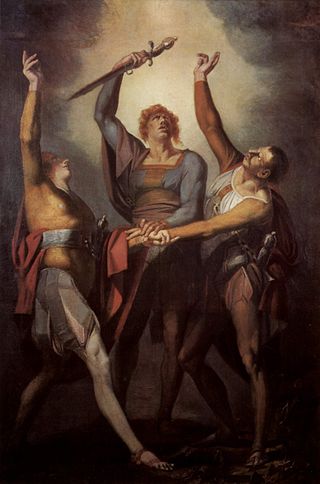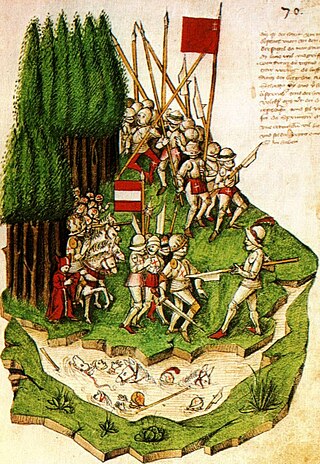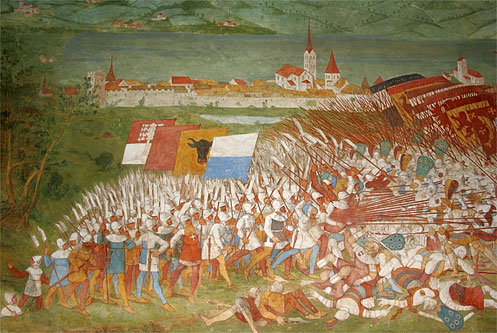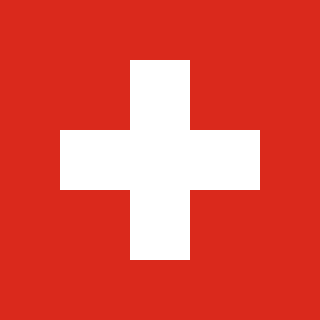Landschlacht, Switzerland, 7 January 2017
It is normal to underestimate the Swiss.

In fact other nations generally don´t see and rarely think about the Swiss.
And the Swiss themselves don´t help themselves in this regard.
To the outside world, the French-speaking Swiss to the west of the country seem little different from the French of France.
The Italian-speaking Swiss to the south of the country are easily mistaken for slightly stiff-necked Italians.
The German-speaking Swiss who dominate the country are overlooked as Germans under severe sedation.
Much to the delight and disgust of the Romansh, mostly resident in Canton Graubünden and less than 1% of the Swiss population, the folks of Switzerland´s fourth official language are mostly ignored.
But underestimating the Swiss and seeing them only through clichés tends to be a mistake.
Consider the Swiss military.
And think about these questions…
How does a country located smack dab in the centre of Europe manage to maintain over 500 years of neutrality?

How can a country that is known for being a champion of peace and humanitarianism be also simultaneously armed to the teeth?
Of all the militaries in the world, why are the Swiss called upon to defend the life of the Pope?

To begin a journey into the mindset of the Swiss, first let´s travel back in time and wander northwest of Switzerland…
Nancy, France, 7 January 1477
The Battle of Nancy has been over for two days.

An Italian page has found the body of Charles the Bold (Charles le Téméraire – Charles the Reckless)(Charles Martin, Duke of Burgundy, Count of Charolais, Grand Duke of the West, Knight of the Golden Fleece, Count of Nevers, Seigneur de Croy), naked on a frozen pond, half eaten by wolves, his skull cloven by a Swiss battleaxe.
Only the scars on his body make Charles´ body recognisable.

(Digression Alert: It is this difficulty to identify the body that suggested the fictional hypothesis that Charles survived the battle and was granted asylum in Pimlico, in the heart of London, that was the basis of the plot of the 1949 film Passport to Pimlico.)

(In post-WWII London, an unexploded bomb detonates in Miramont Gardens, Pimlico.
The explosion reveals a buried cellar containing artwork, coins, jewellery and an ancient manuscript.
The document is authenticated by the historian Professor Hatton-Jones as a royal charter of Edward IV that ceded the house and its estates to Charles VII, the last Duke of Burgundy, when he had sought refuge in England after being presumed dead at the 1477 Battle of Nancy.
As the charter had never been revoked, an area of Pimlico is declared to be a legal part of Burgundy.)
(Screenwriter T.E.B. Clarke was also inspired by an incident during the Second World War when the maternity ward of the Ottawa Civic Hospital was temporarily declared international territory by the Canadian government so when Princess Juliana of the Netherlands gave birth, baby Margriet was born on “Dutch” territory (born 19 January 1943) and would not lose her right to the Dutch throne.)

Above: Princess Margriet of the Netherlands
Above: The former Ottawa Civic Hospital, now called the Ottawa General Hospital, a former employer of mine had me work there as a security guard, 1993-1994
(Canadian actor Dan Aykroyd (born 1 July 1952) and current Prime Minister Justin Trudeau (born 25 December 1971) were also born at this hospital.)

Above: Dan Aykroyd

Above: Canadian Prime Minister Justin Trudeau
Thus endeth the digression.
Back to Charles the Bold and the Swiss.
In 1469 Duke Sigismund of Hapsburg of Austria assigned his possessions in the Alsace as a fiefdom to the Duke of Burgundy, Charles the Bold, so as to have these Alsatian territories better protected against the expansion of the Eidgenossen (Old Swiss Confederacy).
For the Swiss were proving to be troublesome…
Until about 1220 no one took much notice of the remote valleys and villages in what is now Switzerland.
Then the route over the St. Gotthard Pass opened.

And everyone wanted to muscle in on the lucrative trade with the Mediterranean.
To do that meant controlling the farmers, whose valleys had sole access to the northern approach to the Pass.
The farmers sought protection from the Holy Roman Emperor himself.
The communities of Uri and Schwyz were granted imperial freedom, meaning that the Emperor was their only boss.
But this semi-autonomy wasn´t enough of a guarantee.
Enter the Austrians of the Hapsburg monarchy.
They sent in bailiffs who threw their weight around to get what they wanted.
All that did was push the Swiss closer together.
Rütli Meadow, Canton Uri, Switzerland, 1 August 1291
Walter Fürst of Canton Uri, Werner Stauffacher of Canton Schwyz and Arnold von Melchtal of Canton Unterwalden met – on a sloping, lumpy meadow with grazing cows and protruding rocks with a splendid lake and mountain view – and swore an oath of mutual support against the Austrians.
They stood in the August sunshine, placed their left hands together, one on top of the other, raised their right hands above their heads in a honour salute and swore to help one another through thick and thin, in peace and war, forever.

Lake Ägeri, Switzerland, 15 November 1315
In 1314 tensions between the Habsburgs and the Swiss heightened when Duke Louis IV of Bavaria and Frederick the Handsome of the Habsburgs each claimed the crown of the Holy Roman Emperor.
The Swiss supported Louis IV because they feared the Hapsburgs would annex their lands, which they had already tried to do in the late 1200s.
War eventually broke out after the Swiss of Schwyz raided the Habsburg-protected Einsiedeln Abbey over access to pasture lands.
Frederick´s brother, Leopold of Austria, led a large army to crush the rebellious Swiss.

Leopold planned a surprise attack from the south via Lake Aegeri (Ägerisee) and the Morgarten Pass, counting on complete victory, for the Swiss lacked both the training as well as the equipment of the Habsburg knights.
The Swiss Confederates of Schwyz were supported by the Confederates of Uri, while the Confederates of Unterwalden erected fortifications west of the village of Arth in anticipation of a Habsburg approach from that direction.
The Confederates of Schwyz and Uri prepared a road block and an ambush point between Ägerisee and Morgarten Pass, where a small path led between a steep slope and a swamp.
The Swiss led by Werner Stauffacher of Schwyz had 1,500 infantry and archers.
The Austrians led by Leopold I had 5,500 infantry and 2,500 heavy cavalry.
When the Swiss ambushed the Austrians from above with rocks, logs and battleaxes, the Austrians had no room to defend themselves and suffered a crushing defeat.

The Swiss, unfamiliar with the custom of battles between knights, brutally butchered retreating troops and anyone unable to flee.
And the Swiss made an important and enduring discovery at this battle.
They learned that displaying greater cohesion than any equal force set against them, the Swiss could defeat anyone.
In March 1316, Holy Roman Emperor Louis IV confirmed the rights and privileges of the Forest Cantons.
However, Leopold proposed another attack against the Swiss Confederacy.
Neither Swiss nor Habsburg prevailed, so in 1318 they negotiated a truce.
By 1323, the Forest Cantons had made alliances with Cantons Bern and Glarus.
Within 40 years, the Cantons of Lucerne, Zug and Zürich had also joined the Confederacy.
By 1384, the expansion of the Swiss Confederacy was colliding with Austrian interests.
The interests of Austria were further undermined in the Pact of Konstanz – a union of Zürich, Zug, Solothurn and 51 cities of German Swabia.
Without formal declaration of war or any form of central organisation, the Swiss attacked the Austrian strongholds of Rapperswil, Rothenburg, Cham, Wolhusen, Entlebuch, Sempach, Meienberg, Reichensee and Willisau.
The Austrians had had enough.
Duke Leopold assembled his troops and declared war on the Swiss.
The Austrians gathered together at Brugg, marched south to Zofingen and Willisau, intending to ravage the Lucerne coutryside, cutting down corn and destroying the harvests along their route.
The town of Willisau was plundered and razed and the Austrian army moved on to Sursee on Lake Sempach, heading towards the town of Sempach.
Leopold´s men taunted those behind Sempach´s walls and an Austrian knight waved a noose at them and promised he would use it on their leaders.
The Swiss Confederation army, assembled at the bridge over the Reuss River at Gisikon, marched towards Sempach, hoping to catch the Austrians still there and press them against the Lake.
Sempach, Switzerland, 9 July 1386
12:00 – The two armies make contact 2 km outside of Sempach, to their mutual surprise for both were on the move and not in battle formation, but both sides quickly form ranks.
The Swiss held the wooded high ground close to the village of Hildisrieden.
Since the terrain was not deemed suitable for a cavalry attack, Leopold´s knights dismounted.
How and at what point the battle turned in favour of the outnumbered Swiss is a matter of debate.
Perhaps it was the midday heat, which wore out the Austrian knights wearing heavy armour much more than the lightly armed Swiss (some of whom had no other armour than a wooden plank tied to their left arms as shields).
Perhaps the Austrians fatally underestimated the Swiss.
The Swiss broke through the Austrian ranks and routed the enemy army completely.
Many Austrian nobles and knights were slain, including Duke Leopold.
The Battle of Sempach came to be seen as the decisive turning point between the foundation of the Confederacy as a loose pact in the 14th century and its growth into a significant and military power during the 15th century.

The Austrians soon signed an armistice and peace treaty.
Sempach had been a severe blow to Austrian interests and the Swiss Confederacy could now expand unchecked.
No Swiss history book is complete without mentioning Sempach, a battle that means nothing to most Europeans, but still commemorated every year by the Swiss.
Sempach secured Swiss independence and their reputation as soldiers to be reckoned with.
Fast forward to 1476.
Burgundy is one of the richest and biggest powers in Europe under its Duke, Charles the Bold.

Above: Charles Martin the Bold, last Duke of Burgundy (1433 – 1477)
Charles rules over a large part of western Europe, from the Netherlands and Belgium through northern France and Alsace down towards Geneva.

With France and England having spent the previous century fighting each other to a standstill, while Germany and Italy remain divided into piecemeal states, the way is clear for Burgundy to rule the Continental roost.
As previously mentioned, in 1469 Duke Sigismund of Hapsburg of Austria had assigned his possessions in the Alsace as a fiefdom to the Duke of Burgundy, Charles the Bold, so as to have these Alsatian territories better protected against the expansion of the Eidgenossen (Old Swiss Confederacy).
Charles the Bold´s embargo politics against the cities of Basel, Strasbourg and Mulhouse, directed by his reeve Peter von Hagenbach, prompted these cities to appeal to the Swiss Confederacy for help.
On 30 November 1475, Charles seized Nancy in Lorraine, then marched against the Swiss.
Charles marched to Grandson, recently captured by the Swiss, where he had all 412 men of the Swiss garrison hanged or drowned in Lake Neuchatel despite their capitulation on 28 February 1476.

The shocking and horrible execution lasted four hours.
Charles hoped to fill the Swiss with dread, to break the will of the Swiss by killing any of their countrymen he could apprehend.
Instead he united the Swiss as never before.
The Swiss confederate forces had no news of the fate of the Grandson garrison and assembled their forces in the hope of lifting the siege.
On 2 March 1476, Charles was attacked by the Swiss confederate forces and suffered a shameful defeat.

Charles was compelled to flee, abandoning his artillery along with many provisions and valuables.
At insignificant cost to themselves, the Swiss had humiliated the greatest duke in Europe, defeating one of the most feared armies and taken a most impressive amount of treasure.
Charles succeeded in raising a fresh army of 30,000 men.
Stung by his defeat at Grandson, Charles was determined to recover his territories and fortifications in the Pays de Vaud (in the present day French-speaking parts of Switzerland), then march on and attack the city of Berne, his greatest enemy among the Swiss cantons.
Charles´ first objective was the strategic lakeside town of Morat, on the eastern shore of Lac Morat.
On 22 June 1476, the Burgundians were resoundingly defeated and never truly recovered.

For some three miles along the lakeside many Burgundians died that day.
Charles´ dream of revenge against the Swiss should have ended that day, for his defeat at Morat spelled the beginning of the end for the Duchy of Burgundy, but he would doggedly struggle on against his foes.
Charles escaped to Morges and then to Pontarlier, where he stayed for months, in a deep depression.
On 6 October 1476, Charles lost Nancy to the Swiss who returned it to the Duke of Lorraine.
Making a last effort, Charles formed a new army and arrived in the dead of winter before the walls of Nancy.

Having lost many of his troops through the severe cold, it was only with a few thousand men that Charles met the joint forces of the Lorrainers and the Swiss at the Battle of Nancy on 5 January 1477.
Charles´ body, as abovementioned, was found two days later.

With the death of Charles the Bold, the dynasty of the Dukes of Burgundy died out.
The Flemish territories of Burgundy became a possession of the Austrian Habsburgs.
The French territories of Burgundy reverted to the crown of France.
The victories of the Swiss Confederation over one of the most powerful military forces in Europe at the time gained the Swiss a reputation of near invincibility.
The wars with Burgundy marked the beginning of the rise of Swiss mercenaries on the battlefields of Europe.
One man´s recklessness and his underestimation of the Swiss led to an inglorious and undignified death and ended both a dynasty and an empire.
(To be continued…)

Sources: Wikipedia / Diccon Bewes, Swiss Watching / Xenophobe´s Guide to the Swiss / The Rough Guide to France

